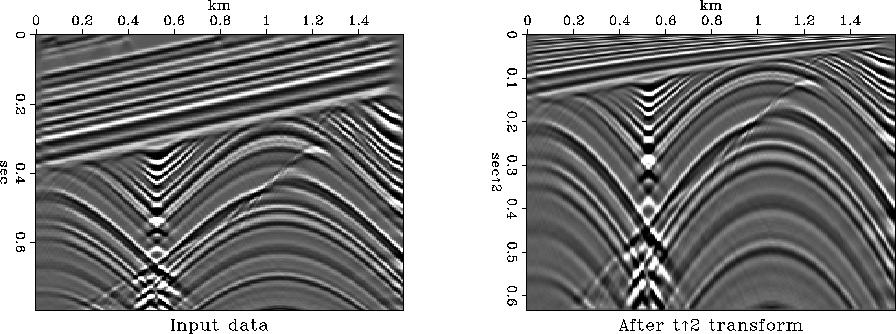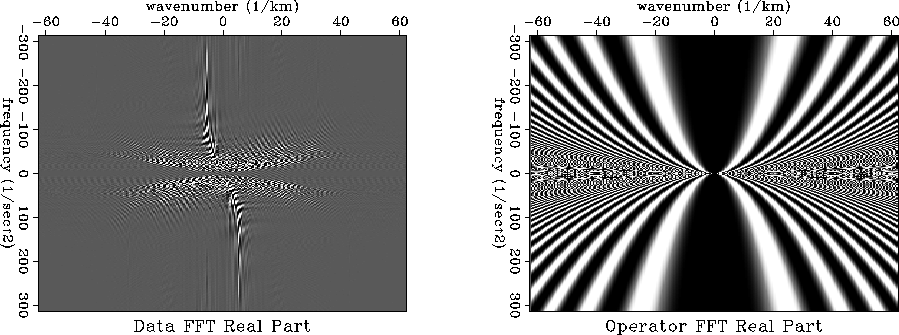




Next: Improving the accuracy of t
Up: Fomel: Spectral velocity continuation
Previous: Problem formulation
Introducing the change of variable  , we can transform
equation (1) to the form
, we can transform
equation (1) to the form
|  |
(5) |
whose coefficients don't depend on the time variables. Double Fourier
transform in  and x further simplifies equation (5)
to the ordinary differential equation
and x further simplifies equation (5)
to the ordinary differential equation
|  |
(6) |
where the frequency  corresponds to the time coordinate
corresponds to the time coordinate
 , and k is the wavenumber in x. Equation (6) has
an explicit analytical solution
, and k is the wavenumber in x. Equation (6) has
an explicit analytical solution
|  |
(7) |
which defines a very simple algorithm for the numerical velocity
continuation. The algorithms consists of the following steps:
- 1.
- Transform the input from a regular grid in t to a regular grid
in
 .
. - 2.
- Apply FFT in x and
 .
. - 3.
- Multiply by the all-pass phase-shift filter
 .
. - 4.
- Inverse FFT in x and
 .
. - 5.
- Inverse transform to a regular grid in t.
t2
Figure 2 Synthetic seismic data before (left) and after
(right) transformation to the  grid.
grid.





Figure 2 shows a simple synthetic model of seismic
reflection data from (Claerbout, 1995) before and after
transforming the grid, regularly spaced in t, to a grid, regular in
 . The left plot of Figure 3 shows the Fourier
transform of the data. Except for the nearly vertical event, which
corresponds to a stack of parallel layers in the shallow part of the
data, the data frequency range is contained near the origin in the
. The left plot of Figure 3 shows the Fourier
transform of the data. Except for the nearly vertical event, which
corresponds to a stack of parallel layers in the shallow part of the
data, the data frequency range is contained near the origin in the
 space. The right plot of Figure 3 shows the
phase-shift filter for continuation from zero imaging velocity (which
corresponds to unprocessed data) to the velocity of 1 km/sec. The
rapidly oscillating part (small frequencies and large wavenumbers) is
exactly in the place, where the data spectrum is zero and corresponds
to physically impossible reflection events.
space. The right plot of Figure 3 shows the
phase-shift filter for continuation from zero imaging velocity (which
corresponds to unprocessed data) to the velocity of 1 km/sec. The
rapidly oscillating part (small frequencies and large wavenumbers) is
exactly in the place, where the data spectrum is zero and corresponds
to physically impossible reflection events.
t2-fft
Figure 3 Left: the real part of the data Fourier
transform. Right: the real part of the velocity continuation
operator (continuation from 0 to 1 km/s) in the Fourier domain.





Algorithm (7) is very attractive from the practical point
of view because of its efficiency (based on the FFT algorithm). The
operations count is roughly the same as in Stolt migration
(4): two forward and inverse FFTs and forward and inverse
grid transform with interpolation (one complex-number transform in the
case of Stolt migration). Algorithm (7) can be even more
efficient than Stolt method because of the simpler structure of the
innermost loop. However, its practical implementation faces two
difficult problems: artifacts of the t2 grid transform and
wraparound artifacts





Next: Improving the accuracy of t
Up: Fomel: Spectral velocity continuation
Previous: Problem formulation
Stanford Exploration Project
5/1/2000
![]() , we can transform
equation (1) to the form
, we can transform
equation (1) to the form

![]() . The left plot of Figure 3 shows the Fourier
transform of the data. Except for the nearly vertical event, which
corresponds to a stack of parallel layers in the shallow part of the
data, the data frequency range is contained near the origin in the
. The left plot of Figure 3 shows the Fourier
transform of the data. Except for the nearly vertical event, which
corresponds to a stack of parallel layers in the shallow part of the
data, the data frequency range is contained near the origin in the
![]() space. The right plot of Figure 3 shows the
phase-shift filter for continuation from zero imaging velocity (which
corresponds to unprocessed data) to the velocity of 1 km/sec. The
rapidly oscillating part (small frequencies and large wavenumbers) is
exactly in the place, where the data spectrum is zero and corresponds
to physically impossible reflection events.
space. The right plot of Figure 3 shows the
phase-shift filter for continuation from zero imaging velocity (which
corresponds to unprocessed data) to the velocity of 1 km/sec. The
rapidly oscillating part (small frequencies and large wavenumbers) is
exactly in the place, where the data spectrum is zero and corresponds
to physically impossible reflection events.
